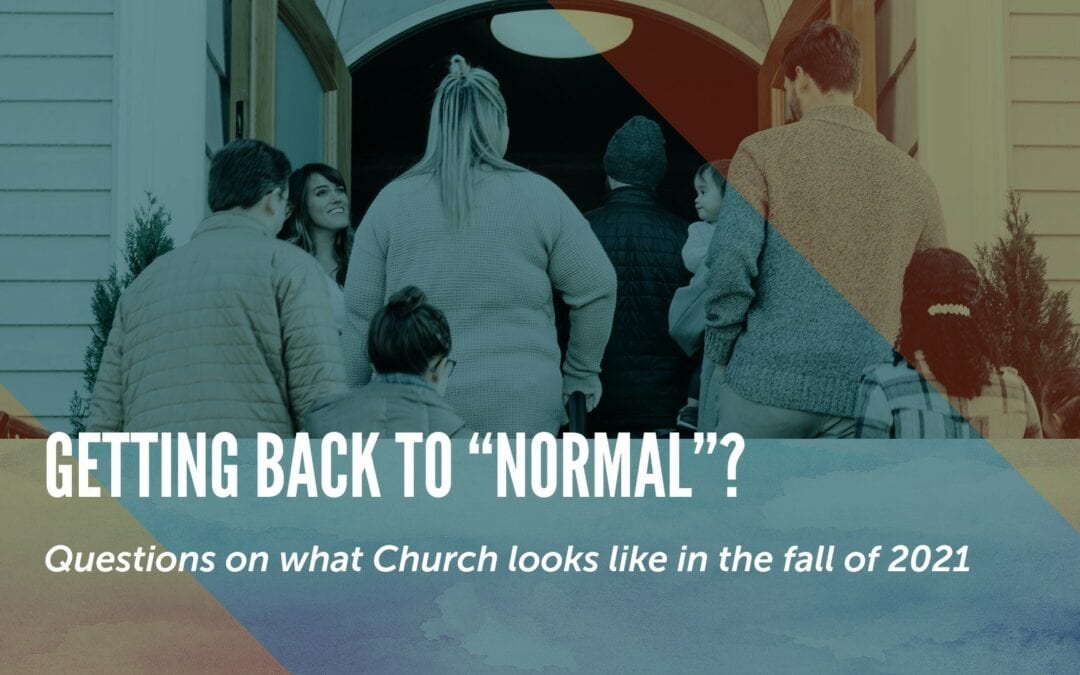It has been far too long since last I posted, and perhaps it’s time that I take up the “pen” once more.
As restrictions in our province continue to lift and case counts continue to go down, while vaccination rates are rising, everyone is starting to talk about things going back to “normal” in the fall. Be it schools, businesses, stores, sports, and yes, even church, many are expecting things to “return to normal” based on current trends. But what does that really mean?
When we say things will “return to normal”, are we, in some sense, suggesting that everything will go back to the way it was before the COVID-19 pandemic? To say we’d be kidding ourselves would be an immense understatement. To do so suggests that we simply forget the last 18 months ever happened – that we live as though 2020 and 2021 are all-but-wiped from the records of history. However, no future historian is going to look back into the history books and see absolutely nothing recorded between March of 2020 to October of 2021 and wonder where they went (even if that’s how we might feel as we’re right in the middle of it). Whether we like to admit it or not, COVID-19 has changed us, but we probably won’t know the full impact of that until further into the future – perhaps a year or more. I was reminded in a conversation lately that Post Traumatic Stress Disorder (PTSD) is labelled POST Traumatic for a reason – it comes after the trauma. So, how has COVID-19 changed us? How will it change us?
My use of PTSD as a comparison is not necessarily meant to suggest that what comes after COVID-19 is all negative (although it inevitably does by its very name). I am more wanting to suggest that when major shifts happen in the world and in our lives, it takes time for the changes they create to come to the surface. Certainly, we can see some of the ways we have changed as a church in this past year. Many of the things we are doing in worship services, for example, would probably have been either unthinkable or even a ‘pipe-dream’ in our pre-COVID existence. We have learned and adapted along the way, but one thing I hope we have come to realize is that the how of worship together is nowhere near as important as the matter of that we worship together. Many of the things, however, have yet to be realized. We have essentially put all children and youth programs ‘on hold’ for the past year and a half. Ladies Coffee break, Carpenteros, and many other official and unofficial ministries of our church have had to postpone, change, or even cancel plans in light of restrictions on travel, group capacity limits, or public health guidelines. So what might these things look like coming out the other side of this?
It is on this point, perhaps more than any other, I would like for us, collectively as a church, to dwell. On the one hand, yes it will be great to start everything back up again. On the other, are we perhaps assuming too much in thinking that things will simply go back to the way they were prior to March of 2020? When we are allowed to have 100% capacity indoors without masks or social distancing, who is actually going to show up? For church? For GEMS and Cadets? Sunday School? Youth? Coffee Break? Will it be the same people we saw before the pandemic? A whole new crowd? Are we even prepared to answer these questions?
One thing we need to keep in mind on the younger end of the spectrum, for example, is that everyone will be 2 years older by this fall than they were the last time many of our programs ran. Some have quietly ‘graduated’, perhaps leaving a bigger gap in their wake because the age groups coming up behind are smaller. So, for example, does it make sense to have a full-blown Sunday School ministry with 2 teachers per grade when we potentially have less than 20 kids total in the age 3 to grade 3 bracket? Is that a valuable use of resources? Does that mean we rethink how we do Sunday School? That we make church more inclusive of kids? That we expand Sunday School to include more ages? These are all important questions, but not ones for only council to decide. They are questions we all need to answer because this is our church and we all have a part to play. And, of course, this is only one piece of the overall puzzle.
Our inevitable tendency as human beings is to be self-serving. We kid ourselves if we think otherwise. Church is no exception. Thus, those who have young kids or teenagers are naturally more passionate about children and youth ministries. Similarly, those in the “third-third” of life are naturally more drawn to ministries to seniors than they are towards ministries to children. One thing this sometimes leads to is forgetting the ‘other’ in the equation. It is not a question of ‘either-or’, but ‘both-and’; and we often need to remind ourselves that the church and its ministries do not exist just for me and my family. This is perhaps even more critical when we return to the question of who is likely to show up once we are able to re-start these ministries.
I recently had the opportunity to attend webinar hosted by Alpha Canada that included a conversation with Ed Stetzer, a leading missiologist and author. In that conversation, Stetzer heavily emphasized the importance of looking beyond “getting back to church” and “getting back to normal” in the fall. He alluded to Jesus’ words “The harvest is plentiful, but the workers are few” from Luke 10:2. The amount of disruption, chaos, confusion, and change that has happened in the last 18 months have left a lot of people with questions far bigger than “will my kid have to wear a mask when they go to school in September?” According to Stetzer, this is perhaps one of the biggest opportunities for the Gospel in our lifetime. One of the most significant opportunities for people to hear, see, and believe that there is so much more to life; that there is a God who cares deeply for His creation and who desires to be in relationship with us. I’m inclined to agree. As churches we can choose to ignore that opportunity and “get back to normal”, meanwhile missing out on what God is doing. Or we can open ourselves up just that little bit more and ask: “how can we be a part of what God is up to?”
One thing I think we all have underemphasized during this pandemic is the fact that God is in control. What has happened has happened for a reason. God has been there every step of the way. He is using and can use this for His glory and our salvation and sanctification. Sure, we can bury our heads in the sand and pretend like 2020 and 2021 never happened, but that is to our own detriment. Or, we can open ourselves up to what God is doing and ask “how can we be a part of this?” That applies to everything that we do individually and as a church.
I don’t know about you, but I’m excited for what comes next. Let’s keep our minds and hearts open for what God is going to do next.


Recent Comments